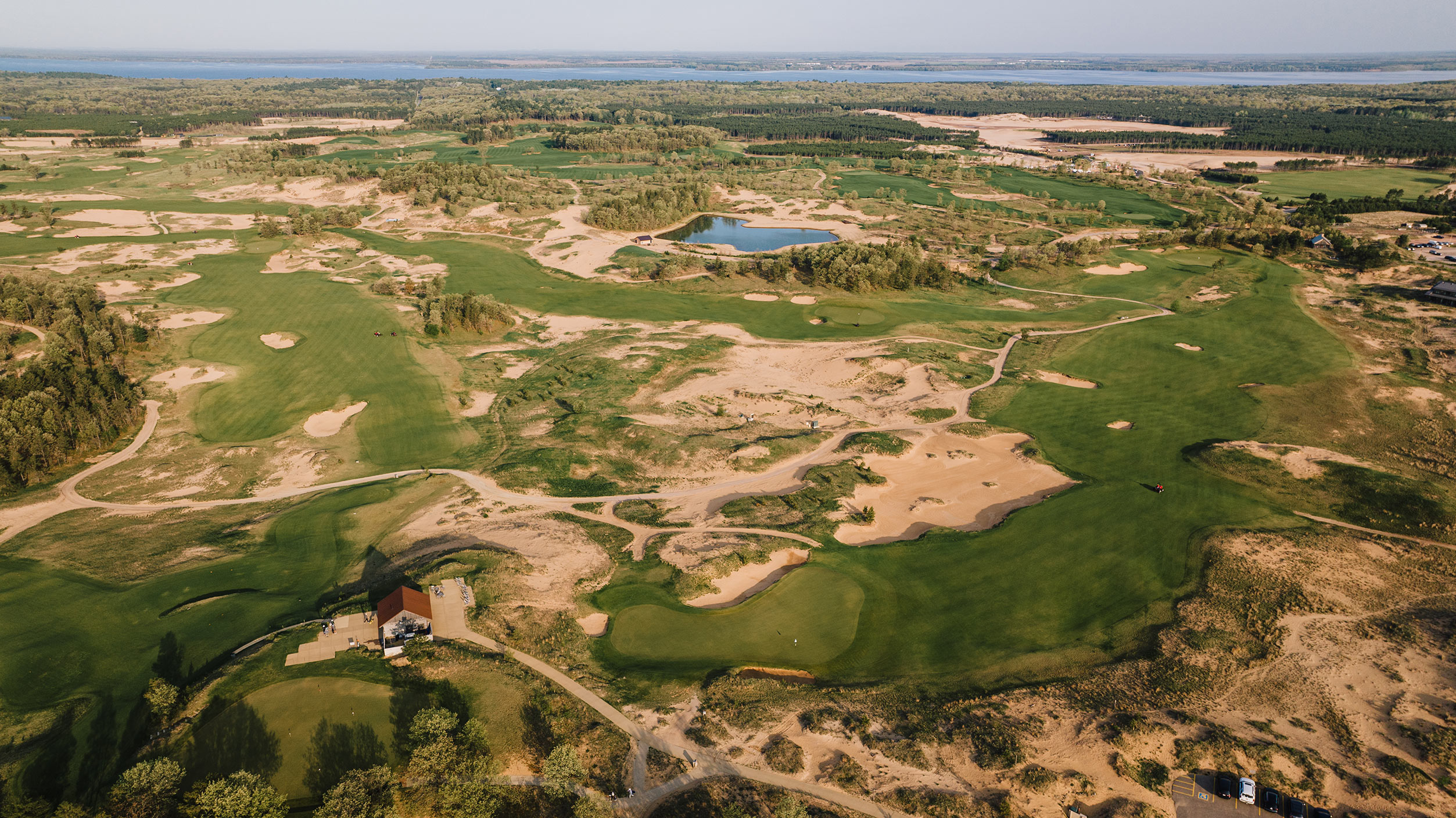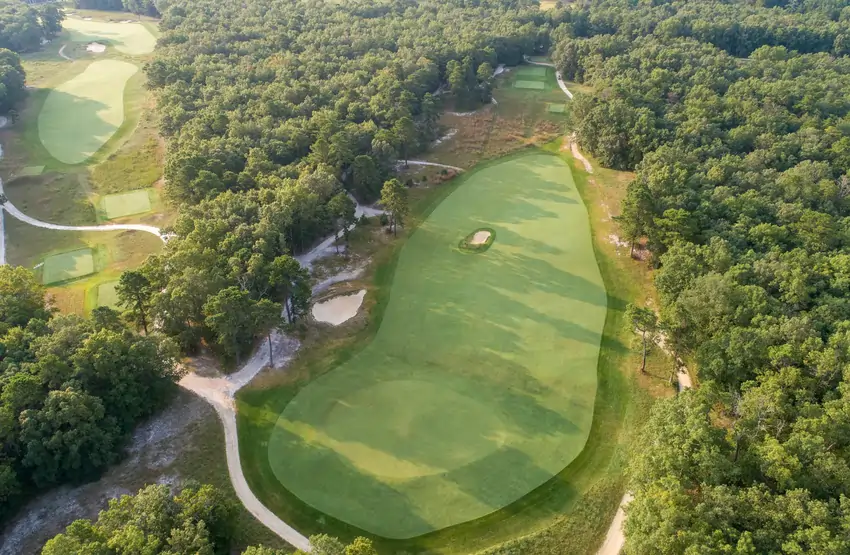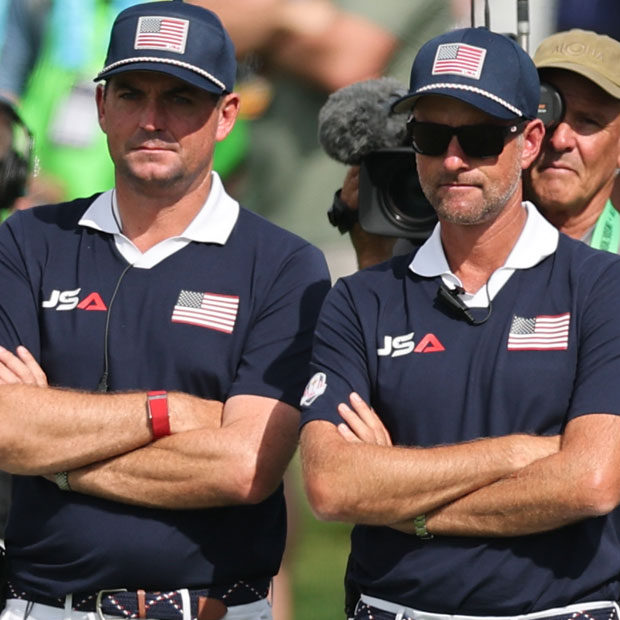Sand Valley
Perhaps the trickiest commission in golf architecture is building the first 18 at a destination resort, but Coore & Crenshaw’s Sand Valley navigates this challenge with aplomb

Teaching Turf: Sand Valley presented by Toro
America’s next great golf resort: Sand Valley
Dream 18: Sand Valley
Golf architect Craig Haltom discovered the site for Sand Valley while exploring Wisconsin with his wife in the early 2000s. Bandon Dunes developer Mike Keiser, with his sons Michael and Chris, bought the property in 2013. The following year, Bill Coore and Ben Crenshaw began to route an 18-hole, par-72 course on hilly, sandy land just south of what is now the resort’s hub. They removed many trees—not only along the hole corridors but also on surrounding hillsides. This clearing exposed dramatic heathland adorned with grasses, shrubs, and flowers, as well as clusters of indigenous black oaks and jack pines. Sand Valley opened to acclaim in 2017.
{{content-block-course-profile-sand-valley-001}}
Take Note…
Craig’s Porch. This small building near the first and 10th tees has everything you need and nothing more. At the risk of being bossy, here’s your meal plan for a morning round: bacon breakfast sandwich before, bratwurst at the turn, ice-cream sandwich after (can of Spotted Cow optional). Every item is cheap. While the overall Sand Valley experience is pricey, the resort’s refusal to gouge guests on concessions is admirable.
{{content-block-course-profile-sand-valley-002}}
Par variety. Sand Valley's layout includes five par 3s, five par 5s, and eight par 4s—an unusual distribution that more courses should adopt. Too many courses are weighed down by the repetitiveness of two-shot holes.
A model of forward-tee design. Sand Valley has tees ranging from 6,938 (Black) to 3,883 (Royal Blue) yards. If you play from the backs or somewhere in the middle, look at the positioning of the forward tees as you walk by. Most are cleverly blended into the terrain, and all are in locations that create sensible, strategic “holes within a hole.” More courses should put this degree of thought into the siting of tees.
Overall Thoughts
Perhaps the trickiest commission in golf course design, albeit one that any architect would kill for, is building the first 18 at a large destination resort. The course has to be distinctive and impressive, but not too unconventional. Since it must establish an overall identity for the resort, it needs to meet golfers halfway, offering a familiar flavor profile as well as a taste of something new. This is the challenge David McLay Kidd faced at Bandon Dunes and Rod Whitman at Cabot Links. These flagship courses extended a general welcome so that the next courses—designed by Tom Doak and Coore & Crenshaw, respectively—could be more peculiar and experimental.
Overall Thoughts
Perhaps the trickiest commission in golf course design, albeit one that any architect would kill to get, is building the first 18 at a large destination resort. The course has to be distinctive and impressive, but not too unconventional. Since it must establish an overall identity for the resort, it needs to meet golfers halfway, offering a familiar flavor profile as well as a taste of something new. This is the challenge David McLay Kidd faced at Bandon Dunes, as did Rod Whitman at Cabot Links. These flagship courses extended a general welcome so that the next courses—designed by Tom Doak and Coore & Crenshaw, respectively—could be more experimental.
Coore & Crenshaw’s Sand Valley navigates the complexity of being first with aplomb. It has returning nines so that Kidd’s Mammoth Dunes doesn’t need to; it has a par of 72 so that Doak’s Sedge Valley can be a par 68. Yet the course also pushes against the expectations of the “retail golfer” (a Keiser term) in several ways. Three different holes—6, 7, and 12—have alternate fairways, and three others—10, 16, and 18—feature center-line bunkers with room on either side, effectively creating two fairways in one. Also, the contouring on and around the greens is as audacious as anything in Coore & Crenshaw’s catalog: interior undulations and exterior runoffs combine to create difficulties, not to mention rewards for precise ball-striking, rarely encountered in public-resort golf.
Sand Valley does not call attention to itself, but for exactly that reason, it occupies an important position at a resort that now boasts a collection of boundary-pushing courses. -GM
2 Eggs
The presentation of Sand Valley, currently overseen by superintendent Joe Jehnsen, couldn’t be better. The fescue fairways are tawny, bouncy, and beautifully blended into the surrounding native areas. Zero notes. The property is spectacular, like the English heathland of Sunningdale turned up to 11, though the terrain on the front nine, consisting of several different paddocks, is somewhat disjointed. The back nine feels more coherent and satisfying, wandering out and back through a single valley. An Egg representing the virtues of both land and design seems about right.
{{content-block-course-profile-sand-valley-003}}
Course Tour

No. 1, par 4, 335 yards
This friendly opener swoops down from Craig’s Porch and up to an elevated green. You can challenge the waste area on the left to shorten the hole, but the approach angle isn’t significantly better. A cautious, well-struck drive out to the right should leave a short enough approach.
{{content-block-course-profile-sand-valley-004}}
No. 2, par 4, 431 yards
The green on this stout par 4 sits higher than its surroundings and, from the fairway, is the most intimidating target at the resort. There are runoffs left, right, and back, in order of severity. The miss is short, but really you just need to hit a good shot. Looking at the green from behind, you can see how built up it is.
This is where Sand Valley fully differentiates itself from Mammoth Dunes, which doesn’t have any holes this exacting.
{{content-block-course-profile-sand-valley-005}}
No. 3, par 3, 216 yards
The dominant feature on Sand Valley’s first par 3 is a big kicker mound that can feed balls to the middle of the green. Just don’t miss right, or you’ll be left with a chip back over the mound from a tight lie to a putting surface that runs away.
{{content-block-course-profile-sand-valley-006}}
No. 4, par 5, 593 yards
The fourth hole serves a clear purpose in the routing: to transport players to the top of a ridge that stands between the main portion the property and the valley containing Nos. 5-7. This is no easy task, given the scale of the landforms, and Coore & Crenshaw likely needed to move some dirt to make No. 4 walkable and golfable. The result, in this case, is not particularly compelling. The shaping of this long, uphill par 5—specifically the way the fairway tacks between waste bunkers—is symmetrical and a bit banal. The strategy isn’t terribly memorable, either: while a drive that hugs the well-guarded left side yields a less obstructed route up the fairway, any three shots that stay out of trouble should do the job.
{{content-block-course-profile-sand-valley-007}}
No. 5, par 3, 175 yards
This drop-shot par 3 has an elegantly sculpted green complex. Take particular note of the rippling short-grass transition behind the green, which fuses with the sixth tee.
{{content-block-course-profile-sand-valley-008}}
No. 6, par 4, 455 yards
The length of this par 4 is a significant defense and may tempt some players to aim for the alternate fairway, which is narrow and surrounded by trouble but shortens the hole. The green looks shallow from the fairway but is in fact 45 yards deep and full of helter-skelter contouring.
{{content-block-course-profile-sand-valley-009}}
Favorite Hole
No. 7, par 5, 568 yards
With its double-dogleg fairway and shock-and-awe hazards, this par 5 like a George Thomas fantasy sketch come to life.
If you bites off a portion of a sandy expanse on the right with your tee shot, you’ll get a view of the green and a chance to reach it in two. If you bail out left, you still have a couple of options. The comfy one is to play your second shot out to the right, completing a conservative zigzag up the hole, but your third will be long and difficult. The aggressive option is to aim over the shoulder of the hill on the left, toward a hidden alternate fairway that offers an ideal angle into the green. To reach this spot, though, you have to trust your line to a completely blind landing area and avoid a long bunker slicing up the middle of the corridor.
The seventh green, tucked into a natural saddle, is in one of the prettiest locations at the resort.

{{content-block-course-profile-sand-valley-010}}
No. 8, par 3, 136 yards
Take in this short par 3 from the higher back tee, where you’ll be able to see the tiered putting surface and the pushed-up “alligator eye” pot bunker sizing you up from behind the green. This is Coore & Crenshaw’s shaping at its best.
{{content-block-course-profile-sand-valley-011}}
No. 9, par 4, 305 yards
From its elevated tee, this short par 4 looks attackable, but the closer you get to the green, the more danger comes into play. The green resembles something Alister MacKenzie might have built on a similar hillside site: think of a miniature version of the Sitwell green or Pasatiempo’s 16th, with flattish sections separated by severe slopes.
{{content-block-course-profile-sand-valley-012}}
No. 10, par 5, 563 yards
A center-line bunker separates a higher, wider fairway on the right from a lower, narrower one on the left. An accurate drive to the left side opens up an avenue to run your second shot onto the green. From the right, a large waste bunker intervenes.
{{content-block-course-profile-sand-valley-013}}
No. 11, par 4, 405 yards
The fairway on this handsome, lay-of-the-land par 4 is 80 yards wide, but if you steer away from the waste area on the left, the hole will become very long, and the drop-off on the right side of the green will become more of a factor on your approach.
{{content-block-course-profile-sand-valley-014}}
No. 12, par 5, 499 yards
The shortest of Sand Valley’s par 5s, the 12th hole is more easily reachable from the left fairway, which is partly concealed from the tee and requires a carry to reach.
{{content-block-course-profile-sand-valley-015}}
No. 13, par 4, 428 yards
Here is a good place to enjoy the artistry of Coore & Crenshaw’s tie-in work—that is, their blending of manufactured golf features with the natural landscape. To the right of the beginning of the 13th fairway is a large sandy blowout that predated the course; to the left of the tee-shot landing zone is a manufactured one. Without this information, I doubt any golfer would be able to tell the difference.
{{content-block-course-profile-sand-valley-016}}
No. 14, par 3, 200 yards
This par 3 faintly resembles the 17th at Bandon Trails, descending from an exposed tee to a sheltered target framed by native vegetation. The contouring of the Sand Valley green, however, is a touch bland by comparison.
{{content-block-course-profile-sand-valley-017}}
No. 15, par 4, 419 yards
As Andy has argued, the three mounds guarding the front of this green are easier to manage from the treacherous left edge of the fairway than from the safer right side.
This hole also provides a final moment to appreciate the tree-covered knoll that the 10th green, 11th tee, 15th green, and 16th tee gather around. It’s a serene spot with well-tended walking paths that give the green-to-tee transitions a life of their own.
{{content-block-course-profile-sand-valley-018}}
No. 16, par 4, 451 yards
The deep, scraggly bunker defending the front-right side of the green influences play back to the tee: if you thread your drive between the center-line fairway bunker and the native hillside to the left, the green-side bunker won’t be in the way of your uphill approach. Classic strategy applied to ideal land for golf.
{{content-block-course-profile-sand-valley-019}}
No. 17, par 3, 236 yards
This punchbowl par 3 is pure fun: smack a long club up there and enjoy the suspense before finding out where it ended up. What really elevates the hole, though, is the intricacy of the green. To avoid the large swale front left and get close to pins on the right, you have to hit a savvy tee shot.
{{content-block-course-profile-sand-valley-020}}
No. 18, par 5, 523 yards
A grand finisher, this climbing par 5 has a visual impact similar to that of Coore & Crenshaw’s 18th at Sand Hills. The second shot is nerve-wracking—partly blind, with a sandy chasm intruding from the right—but can be made less so if played from between the two bunkers on the right half of the fairway. The huge green boomerangs around a billy-club-shaped bunker.
{{content-block-course-profile-sand-valley-021}}
Additional Content
Leave a comment or start a discussion
Get full access to exclusive benefits from Fried Egg Golf
- Member-only content
- Community discussions forums
- Member-only experiences and early access to events



















Leave a comment or start a discussion
Lorem ipsum dolor sit amet, consectetur adipiscing elit. Suspendisse varius enim in eros elementum tristique. Duis cursus, mi quis viverra ornare, eros dolor interdum nulla, ut commodo diam libero vitae erat. Aenean faucibus nibh et justo cursus id rutrum lorem imperdiet. Nunc ut sem vitae risus tristique posuere. uis cursus, mi quis viverra ornare, eros dolor interdum nulla, ut commodo diam libero vitae erat. Aenean faucibus nibh et justo cursus id rutrum lorem imperdiet. Nunc ut sem vitae risus tristique posuere.